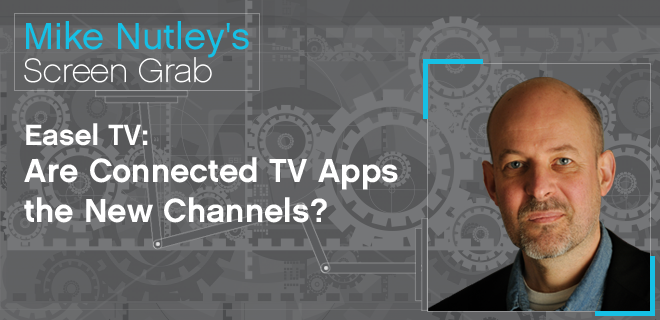
Easel TV specialises in building apps for connected TVs, with clients including broadcasters, pay-TV operators, content producers and major consumer brands. I spoke to AdMonsters Screens speaker Bill Scott, COO of Easel, and asked him to explain the company’s proposition.
 BS: Our differentiator is that our apps feel much more like a TV channel than a website. Our competitors are typically building websites on the TV, and however well-designed they are, they still fundamentally demand the lean-forward navigational model, which is not natural for the television. When we build apps, the lean-back experience is the most important thing. An app is better if it’s simpler and focuses on the content, rather than having a lot of complexity like something you’d get on a website or on an iPhone.
BS: Our differentiator is that our apps feel much more like a TV channel than a website. Our competitors are typically building websites on the TV, and however well-designed they are, they still fundamentally demand the lean-forward navigational model, which is not natural for the television. When we build apps, the lean-back experience is the most important thing. An app is better if it’s simpler and focuses on the content, rather than having a lot of complexity like something you’d get on a website or on an iPhone.
Our software platform, Suggested TV, is a series of tools that allow you to assemble a televisual experience on connected TV devices. There’s a set of server components that run in the cloud, and those components present a set of data to the players that run on each of the connected TV devices. Those players are designed to take that set of data and create an experience that is optimised for the particular device. We have players for Samsung TVs, for LG TVs, for the Virgin Media Tivo platform, and we’re working on one for the Xbox at the moment.
We aim not to build one application that works on all devices, because that’s hard to do, and something that works reliably on all the different platforms isn’t going to be terribly exciting. So we take a different approach, which is to build an app for each platform, but we get a lot of reuse between the different apps because they’re all fundamentally doing the same sort of thing, which is to focus on the video rather than trying to deliver a lot of interactivity.
MN: How analogous is this to the complexity of the mobile phone world with all its variations of hardware and software?
BS: The technologies being used are very similar, and the way the industry is evolving is similar. It’s very fragmented at the moment with a number of different platforms, but we’re expecting there’ll be a certain amount of consolidation over time, so that you’ll have Apple, Android, maybe Microsoft, maybe some open HTML5-type platforms, and that’ll be about it.
Where the parallels stop is in the way the devices are used. A problem with some of the apps that are being developed for connected TVs is that they’ve been built by people who’ve come from a mobile app background, and they’re basically mobile apps on the TV. They’re assuming the same kind of relationship between the user and the app as you get on mobile, which is of course very different to the way people use TV.
TV is very good at some things and very bad at other things. It’s very good at delivering entertainment to a group of people, for example, which is very different to the way you’d use a phone. So the approach that we take focuses on the things that TV is good at, and doesn’t try to do the things that TV is bad at, such as personal transactions, lots of data capture, banking or complex shopping. All these things have been tried on the TV lots of times, but they’ve always failed because they’re not appropriate to the way the device is used.
MN: How big a problem is this proliferation of platforms for people who want a presence on connected TV?
BS: It means that some of these platforms don’t justify the investment required to reach an audience, because there isn’t a critical mass of audience on some of these platforms. And it’s not just that there isn’t a critical mass now. With the likely consolidation that we’re going to see in the industry, some of these platforms will never get critical mass. We can reduce the fragmentation problem, but we can’t get rid of it. So what we’re doing is to make it very easy to move on to new platforms, but it’s still something you’ve got to justify doing, based on the audience you’re going to reach.
MN: What sort of clients do you work for?
BS: We’re a B2B software platform, and we work for any client that wants to deliver a content-based experience to consumers. We’ve done some work with Channel 4 for their propositions for YouView, we’ve done quite a lot of work with Virgin Media and Tivo, building the apps for the Tivo platform – we built the Spotify app for Tivo for example.
We’ve also done a lot of work with All3Media in their first direct-to-consumer propositions, monetising their archive of content. And one of the things we’ve done on the Virgin Media platform is a promotional campaign for HTC around the launch of the HTC One phone. This was an app that was promoted through the Virgin Media platform EPG. You go into the app and you’re watching a TV channel which shows you the commercials for the launch of the phone, but also some documentaries around the making of those commercials, trying to build a little community around the launch of the phone.
The experience changes like a scheduled TV channel can change – although it doesn’t need nearly as much content of course – but the app itself is unchanged. We see apps as the new channels, because what is an app but an interactive channel?
MN: What are the opportunities and challenges for media owners and brands in the world of connected TV?
BS: There’s quite a lot of experimentation going on to see how consumers will use these devices, and there’s an opportunity to get in relatively early in the evolution of the industry. So we’re advising clients to get out there and try things out, to look at the way they can create an experience, to look at the way they can promote content, to look at the way they can bring an audience to these devices, to see what the customer reaction is. And then to be there when the usage of these devices ramps up dramatically.
MN: Do you have a sense of when that will happen?
BS: We’re rapidly getting there, and there are important things happening this summer. We’ve had the launch of YouView; there’s Google TV, which is important because it’s the big monster Google finally moving into television; and Sky launching Now TV effectively as an app that will run on other platforms is very significant as well.
When people buy one of these devices and connect it, and start actively using it, going into the app store and looking at what apps are around, that’s when behaviours start to change. And all those things are happening right now. It won’t be completely mainstream by the end of this year, but it’ll be heading that way.